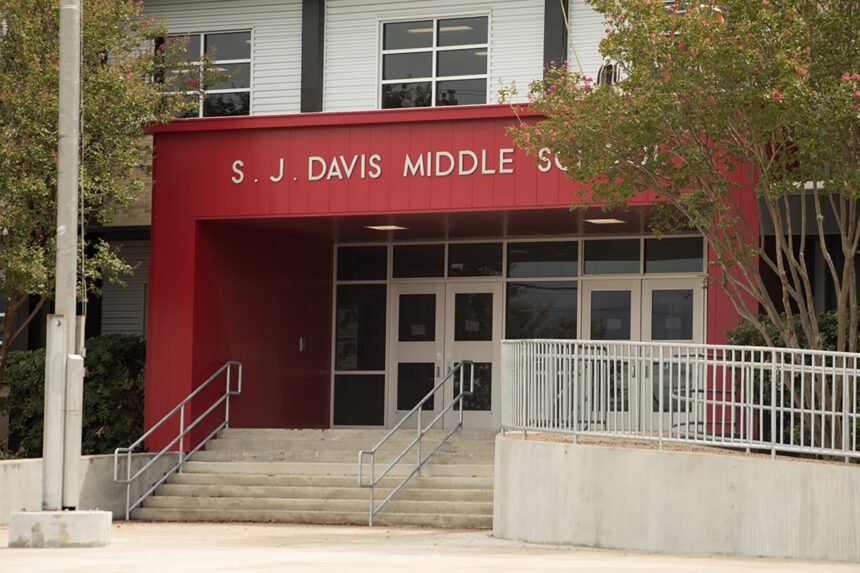Two schools within the San Antonio Independent School District that are deemed “unacceptable” by the state after poor academic performance for two consecutive years will now implement “turnaround plans.”
Hirsch Elementary School and Davis Middle School both received an ‘F’ in the last two rounds of available state accountability ratings from 2022 and 2023. More recent ratings for the 2023-24 school year are held up in state court proceedings, but school districts and campuses know their score and can share them publicly. Most schools in San Antonio haven’t released the most recent scores.
The low ratings at Hirsch and Davis led both schools to maintain a “comprehensive support and improvement status (CIS),” a label the state designates to the lowest performing economically disadvantaged schools. More than 90% of students at those schools are considered economically disadvantaged.
To exit the CIS status, schools need to increase a letter grade and avoid ranking in the bottom 5% of economically disadvantaged schools across Texas for two consecutive years.
Shawn Bird, SAISD’s deputy superintendent for academics and school leadership, said the schools’ 2023-24 ratings “triggered” the need for turnaround plans at both schools and that the plans go into effect this upcoming school year.
On the other hand, he said Hirsch and Davis both saw gains in the most recent state STAAR exam, potentially hinting a a shift in academic performance already taking place.
More third and fourth graders at Hirsch met grade level standards on the 2025 math STAAR compared to last year. All tested grade levels, third through fifth grade, saw improvements on the reading exam too.
Algebra I scores saw a huge jump among Davis students. This year 67% of test takers tested on grade level, compared to only 33% last year. Almost every test saw gains except for seventh grade math and reading.
Campus administrators for the two campuses created turnaround plans with input from parents and teachers, later submitting their plans for SAISD board approval. Part of the turnaround process includes asking administrators why students are performing poorly.
Over at Hirsch, administrators said the need for a turnaround plan came after the school received an ‘F’ rating for 2024. Contributing factors included “the absence of a positive school culture, ineffective teacher collaboration around instructional practices, and a general lack of academic rigor.”
Davis hasn’t shared its 2024 accountability ratings, but said the need for intervention stemmed from a combination of factors:
“Students consistently failed to meet grade-level expectations on STAAR due to weak instructional practices, a lack of a high-quality curriculum, and an ineffective school culture which was exacerbated by weak leadership and poor data utilization.”
The principal at Davis is Joaquín Soliz, who’s been with the school since 2023 and has more than 20 years of education experience. He also served as assistant principal at Sam Houston High School before moving to Davis.
Under its turnaround plan, Hirsch launched a two-year agreement with the University of Virginia Partnership for Education to “build the leadership capacity necessary” for student improvement.
Hirsch also plans to implement a different curriculum, prioritize core instruction, use targeted interventions and tutoring to “close achievement gaps” and monitor data through 90-day cycles.
Davis’ turnaround plan focuses on improving curriculum and instruction with an “emphasis on school culture.” Among other locally created and state approved curriculum, Davis will use the math portion of Bluebonnet Learning, a curriculum created by the state in 2023 with an incentive of $60 per student if a school district chooses to implement it.
Both schools will adjust campus budgets to prioritize spending on new curriculum, leadership training and data collection and analysis.
Through a feedback form shared by campus administrators, several Hirsch teachers said they wanted in-depth training on the new curriculum models, others asked for clarification on 90-day coaching cycles. Teachers also asked that administrators develop opportunities for students to have fun.
“Students need more fun stuff to look forward to throughout the school year (they are bored),” one teacher commented.
Another teacher asked for “grace when working on these new programs and learning as we go.”
SAISD will announce additional schools that need turnaround plans on July 14.
The district puts out a call for in-district charter organizations, including nonprofits and public universities, to submit proposals to take over turnaround campuses every year.
This year’s call is looking specifically for organizations with elementary or middle school models, or an innovation model that “reimagines traditional schooling.”
Known as 1882 partnerships, school districts can turn over failing campuses to nonprofit charter school operators in lieu of facing potential state takeover.
If even one campus receives a failing accountability rating five years in a row, the state is able to take over a school district and appoint a new board and superintendent.
SAISD has more than 20 campuses that received failing grades under the 2022-23 accountability ratings.













